Chapter-06 Lines and Angles
6.1 Introduction
In Chapter 5, you have studied that a minimum of two points are required to draw a line. You have also studied some axioms and, with the help of these axioms, you proved some other statements. In this chapter, you will study the properties of the angles formed when two lines intersect each other, and also the properties of the angles formed when a line intersects two or more parallel lines at distinct points. Further you will use these properties to prove some statements using deductive reasoning (see Appendix 1). You have already verified these statements through some activities in the earlier classes.
In your daily life, you see different types of angles formed between the edges of plane surfaces. For making a similar kind of model using the plane surfaces, you need to have a thorough knowledge of angles. For instance, suppose you want to make a model of a hut to keep in the school exhibition using bamboo sticks. Imagine how you would make it? You would keep some of the sticks parallel to each other, and some sticks would be kept slanted. Whenever an architect has to draw a plan for a multistoried building, she has to draw intersecting lines and parallel lines at different angles. Without the knowledge of the properties of these lines and angles, do you think she can draw the layout of the building?
In science, you study the properties of light by drawing the ray diagrams. For example, to study the refraction property of light when it enters from one medium to the other medium, you use the properties of intersecting lines and parallel lines. When two or more forces act on a body, you draw the diagram in which forces are represented by directed line segments to study the net effect of the forces on the body. At that time, you need to know the relation between the angles when the rays (or line segments) are parallel to or intersect each other. To find the height of a tower or to find the distance of a ship from the light house, one needs to know the angle formed between the horizontal and the line of sight. Plenty of other examples can be given where lines and angles are used. In the subsequent chapters of geometry, you will be using these properties of lines and angles to deduce more and more useful properties.
Let us first revise the terms and definitions related to lines and angles learnt in earlier classes.
6.2 Basic Terms and Definitions
Recall that a part (or portion) of a line with two end points is called a line-segment and a part of a line with one end point is called a ray. Note that the line segment $A B$ is denoted by $\overline{\mathrm{AB}}$, and its length is denoted by $\mathrm{AB}$. The ray $\mathrm{AB}$ is denoted by $\overrightarrow{\mathrm{AB}}$, and a line is denoted by $\overleftrightarrow{A B}$. However, we will not use these symbols, and will denote the line segment $\mathrm{AB}$, ray $\mathrm{AB}$, length $\mathrm{AB}$ and line $\mathrm{AB}$ by the same symbol, $\mathrm{AB}$. The meaning will be clear from the context. Sometimes small letters $l, m, n$, etc. will be used to denote lines.
If three or more points lie on the same line, they are called collinear points; otherwise they are called non-collinear points.
Recall that an angle is formed when two rays originate from the same end point. The rays making an angle are called the arms of the angle and the end point is called the vertex of the angle. You have studied different types of angles, such as acute angle, right angle, obtuse angle, straight angle and reflex angle in earlier classes (see Fig. 6.1).

Fig. 6.1 : Types of Angles
An acute angle measures between $0^{\circ}$ and $90^{\circ}$, whereas a right angle is exactly equal to $90^{\circ}$. An angle greater than $90^{\circ}$ but less than $180^{\circ}$ is called an obtuse angle. Also, recall that a straight angle is equal to $180^{\circ}$. An angle which is greater than $180^{\circ}$ but less than $360^{\circ}$ is called a reflex angle. Further, two angles whose sum is $90^{\circ}$ are called complementary angles, and two angles whose sum is $180^{\circ}$ are called supplementary angles.
You have also studied about adjacent angles in the earlier classes (see Fig. 6.2). Two angles are adjacent, if they have a common vertex, a common arm and their non-common arms are on different sides of the common arm. In Fig. 6.2, $\angle \mathrm{ABD}$ and $\angle \mathrm{DBC}$ are adjacent angles. Ray $\mathrm{BD}$ is their common arm and point $\mathrm{B}$ is their common vertex. Ray $\mathrm{BA}$ and ray $\mathrm{BC}$ are non common arms. Moreover, when two angles are adjacent, then their sum is always equal to the angle formed by the two non-

Fig. 6.2 : Adjacent angles common arms. So, we can write
$\angle \mathrm{ABC}=\angle \mathrm{ABD}+\angle \mathrm{DBC} .$
Note that $\angle \mathrm{ABC}$ and $\angle \mathrm{ABD}$ are not adjacent angles. Why? Because their noncommon arms $\mathrm{BD}$ and $\mathrm{BC}$ lie on the same side of the common arm BA.
If the non-common arms $\mathrm{BA}$ and $\mathrm{BC}$ in Fig. 6.2, form a line then it will look like Fig. 6.3. In this case, $\angle \mathrm{ABD}$ and $\angle \mathrm{DBC}$ are called linear pair of angles.

Fig. 6.3 : Linear pair of angles
You may also recall the vertically opposite angles formed when two lines, say $\mathrm{AB}$ and $\mathrm{CD}$, intersect each other, say at the point $\mathrm{O}$ (see Fig. 6.4). There are two pairs of vertically opposite angles.

Fig. 6.4 : Vertically opposite angles
One pair is $\angle \mathrm{AOD}$ and $\angle \mathrm{BOC}$. Can you find the other pair?
6.3 Intersecting Lines and Non-intersecting Lines
Draw two different lines PQ and RS on a paper. You will see that you can draw them in two different ways as shown in Fig. 6.5 (i) and Fig. 6.5 (ii).

Fig. 6.5 : Different ways of drawing two lines
Recall the notion of a line, that it extends indefinitely in both directions. Lines PQ and RS in Fig. 6.5 (i) are intersecting lines and in Fig. 6.5 (ii) are parallel lines. Note that the lengths of the common perpendiculars at different points on these parallel lines is the same. This equal length is called the distance between two parallel lines.
6.4 Pairs of Angles
In Section 6.2, you have learnt the definitions of some of the pairs of angles such as complementary angles, supplementary angles, adjacent angles, linear pair of angles, etc. Can you think of some relations between these angles? Now, let us find out the relation between the angles formed when a ray stands on a line. Draw a figure in which a ray stands on a line as shown in Fig. 6.6. Name the line as $\mathrm{AB}$ and the ray as OC. What are the angles formed at the $\mathrm{O}$ ? They are $\angle \mathrm{AOC}, \angle \mathrm{BOC}$ and $\angle \mathrm{AOB}$.

Fig. 6.6 : Linear pair of angles point
Can we write $\angle \mathrm{AOC}+\angle \mathrm{BOC}=\angle \mathrm{AOB}$ ? (1)
Yes! (Why? Refer to adjacent angles in Section 6.2)
What is the measure of $\angle \mathrm{AOB}$ ? It is $180^{\circ}$. (Why?) (2)
From (1) and (2), can you say that $\angle \mathrm{AOC}+\angle \mathrm{BOC}=180^{\circ}$ ? Yes! (Why?)
From the above discussion, we can state the following Axiom:
Axiom 6.1 : If a ray stands on a line, then the sum of two adjacent angles so formed is $180^{\circ}$.
Recall that when the sum of two adjacent angles is $180^{\circ}$, then they are called a linear pair of angles.
In Axiom 6.1, it is given that ‘a ray stands on a line’. From this ‘given’, we have concluded that ’the sum of two adjacent angles so formed is $180^{\circ}$ ‘. Can we write Axiom 6.1 the other way? That is, take the ‘conclusion’ of Axiom 6.1 as ‘given’ and the ‘given’ as the ‘conclusion’. So it becomes:
(A) If the sum of two adjacent angles is $180^{\circ}$, then a ray stands on a line (that is, the non-common arms form a line).
Now you see that the Axiom 6.1 and statement (A) are in a sense the reverse of each others. We call each as converse of the other. We do not know whether the statement (A) is true or not. Let us check. Draw adjacent angles of different measures as shown in Fig. 6.7. Keep the ruler along one of the non-common arms in each case. Does the other non-common arm also lie along the ruler?

Fig. 6.7 : Adjacent angles with different measures
You will find that only in Fig. 6.7 (iii), both the non-common arms lie along the ruler, that is, points $\mathrm{A}, \mathrm{O}$ and $\mathrm{B}$ lie on the same line and ray $\mathrm{OC}$ stands on it. Also see that $\angle \mathrm{AOC}+\angle \mathrm{COB}=125^{\circ}+55^{\circ}=180^{\circ}$. From this, you may conclude that statement (A) is true. So, you can state in the form of an axiom as follows:
Axiom 6.2 : If the sum of two adjacent angles is $180^{\circ}$, then the non-common arms of the angles form a line.
For obvious reasons, the two axioms above together is called the Linear Pair Axiom.
Let us now examine the case when two lines intersect each other.
Recall, from earlier classes, that when two lines intersect, the vertically opposite angles are equal. Let us prove this result now. See Appendix 1 for the ingredients of a proof, and keep those in mind while studying the proof given below.
Theorem 6.1 : If two lines intersect each other, then the vertically opposite angles are equal.
Proof : In the statement above, it is given that ’two lines intersect each other’. So, let $\mathrm{AB}$ and $\mathrm{CD}$ be two lines intersecting at $\mathrm{O}$ as shown in Fig. 6.8. They lead to two pairs of vertically opposite angles, namely,
(i) $\angle \mathrm{AOC}$ and $\angle \mathrm{BOD}$ (ii) $\angle \mathrm{AOD}$ and $\angle \mathrm{BOC}$.

Fig. 6.8 : Vertically opposite angles
We need to prove that $\angle \mathrm{AOC}=\angle \mathrm{BOD}$
and $\angle \mathrm{AOD}=\angle \mathrm{BOC}$.
Now, ray $\mathrm{OA}$ stands on line $\mathrm{CD}$.
Therefore, $\angle \mathrm{AOC}+\angle \mathrm{AOD}=180^{\circ}$
Can we write $\angle \mathrm{AOD}+\angle \mathrm{BOD}=180^{\circ}$ ? Yes! (Why?)
From (1) and (2), we can write
$$\angle \mathrm{AOC}+\angle \mathrm{AOD}=\angle \mathrm{AOD}+\angle \mathrm{BOD}$$
This implies that $\angle \mathrm{AOC}=\angle \mathrm{BOD} \quad$ (Refer Section 5.2, Axiom 3)
Similarly, it can be proved that $\angle \mathrm{AOD}=\angle \mathrm{BOC}$
Now, let us do some examples based on Linear Pair Axiom and Theorem 6.1.
Example 1 : In Fig. 6.9, lines PQ and RS intersect each other at point $O$. If $\angle \mathrm{POR}: \angle \mathrm{ROQ}=5: 7$, find all the angles.
Solution : $\angle \mathrm{POR}+\angle \mathrm{ROQ}=180^{\circ}$
(Linear pair of angles)
But $\angle \mathrm{POR}: \angle \mathrm{ROQ}=5: 7$ (Given)
Therefore, $\quad \angle \mathrm{POR}=\frac{5}{12} \times 180^{\circ}=75^{\circ}$

Similarly, $\quad \angle \mathrm{ROQ}=\frac{7}{12} \times 180^{\circ}=105^{\circ}$
Now, $$\begin{aligned} & \angle \mathrm{POS}=\angle \mathrm{ROQ}=105^{\circ} \\ & \angle \mathrm{SOQ}=\angle \mathrm{POR}=75^{\circ} \end{aligned}$$
Example 2 : In Fig. 6.10, ray OS stands on a line POQ. Ray OR and ray OT are angle bisectors of $\angle \mathrm{POS}$ and $\angle \mathrm{SOQ}$, respectively. If $\angle \mathrm{POS}=x$, find $\angle \mathrm{ROT}$.
Solution : Ray OS stands on the line POQ.
Therefore,
$\angle \mathrm{POS}+\angle \mathrm{SOQ}=180^{\circ}$
But,
$$\angle \mathrm{POS}=x$$
Therefore, So,
$x+\angle \mathrm{SOQ} =180^{\circ} \\ \angle \mathrm{SOQ} =180^{\circ}-x$
Now, ray OR bisects $\angle \mathrm{POS}$, therefore,

Fig. 6.10
$$ \begin{aligned} \angle \mathrm{ROS} & =\frac{1}{2} \times \angle \mathrm{POS} \\ & =\frac{1}{2} \times x=\frac{x}{2} \end{aligned} $$
Similarly,
$$ \begin{aligned} \angle \mathrm{SOT} & =\frac{1}{2} \times \angle \mathrm{SOQ} \\ & =\frac{1}{2} \times\left(180^{\circ}-x\right) \\ & =90^{\circ}-\frac{x}{2} \end{aligned} $$
Now,
$$ \begin{aligned} \angle \mathrm{ROT} & =\angle \mathrm{ROS}+\angle \mathrm{SOT} \\ & =\frac{x}{2}+90^{\circ}-\frac{x}{2} \\ & =90^{\circ} \end{aligned} $$
Example 3 : In Fig. 6.11, OP, OQ, OR and OS are four rays. Prove that $\angle \mathrm{POQ}+\angle \mathrm{QOR}+\angle \mathrm{SOR}+$ $\angle \mathrm{POS}=360^{\circ}$.
Solution : In Fig. 6.11, you need to produce any of the rays $\mathrm{OP}, \mathrm{OQ}$, OR or OS backwards to a point. Let us produce ray $\mathrm{OQ}$ backwards to a point $\mathrm{T}$ so that TOQ is a line (see Fig. 6.12).

Fig. 6.11
Now, ray OP stands on line TOQ.
Therefore,
$\angle \mathrm{TOP}+\angle \mathrm{POQ}=180^{\circ}$
(Linear pair axiom)
Similarly, ray OS stands on line TOQ.
Therefore,
$\angle \mathrm{TOS}+\angle \mathrm{SOQ}=180^{\circ}$
$\angle \mathrm{SOQ}=\angle \mathrm{SOR}+\angle \mathrm{QOR}$
So, (2) becomes

Fig. 6.12
$$ \begin{equation*} \angle \mathrm{TOS}+\angle \mathrm{SOR}+\angle \mathrm{QOR}=180^{\circ} \tag{3} \end{equation*} $$
Now, adding (1) and (3), you get
$$ \begin{equation*} \angle \mathrm{TOP}+\angle \mathrm{POQ}+\angle \mathrm{TOS}+\angle \mathrm{SOR}+\angle \mathrm{QOR}=360^{\circ} \tag{4} \end{equation*} $$
But
$\angle \mathrm{TOP}+\angle \mathrm{TOS}=\angle \mathrm{POS}$
Therefore, (4) becomes
$$\angle \mathrm{POQ}+\angle \mathrm{QOR}+\angle \mathrm{SOR}+\angle \mathrm{POS}=360^{\circ}$$
EXERCISE 6.1
1. In Fig. 6.13, lines $\mathrm{AB}$ and $\mathrm{CD}$ intersect at $\mathrm{O}$. If $\angle \mathrm{AOC}+\angle \mathrm{BOE}=70^{\circ}$ and $\angle \mathrm{BOD}=40^{\circ}$, find $\angle \mathrm{BOE}$ and reflex $\angle \mathrm{COE}$.
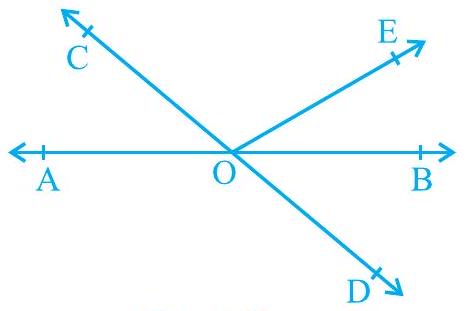
Fig. 6.13
Show Answer
Solution
$A B$ is a straight line, rays $O C$ and $O E$ stand on it.
$\therefore \angle AOC+\angle COE+\angle BOE=180^{\circ}$
$\Rightarrow(\angle AOC+\angle BOE)+\angle COE=180^{\circ}$
$\Rightarrow 70^{\circ}+\angle COE=180^{\circ}$
$\Rightarrow \angle COE=180^{\circ}-70^{\circ}=110^{\circ}$
Reflex $\angle COE=360^{\circ}-110^{\circ}=250^{\circ}$
$CD$ is a straight line, rays $OE$ and $OB$ stand on it.
$\therefore \angle COE+\angle BOE+\angle BOD=180^{\circ}$
$\Rightarrow 110^{\circ}+\angle BOE+40^{\circ}=180^{\circ}$
$\Rightarrow \angle BOE=180^{\circ}-150^{\circ}=30^{\circ}$
2. In Fig. 6.14, lines $X Y$ and $M N$ intersect at $O$. If $\angle \mathrm{POY}=90^{\circ}$ and $a: b=2: 3$, find $c$.
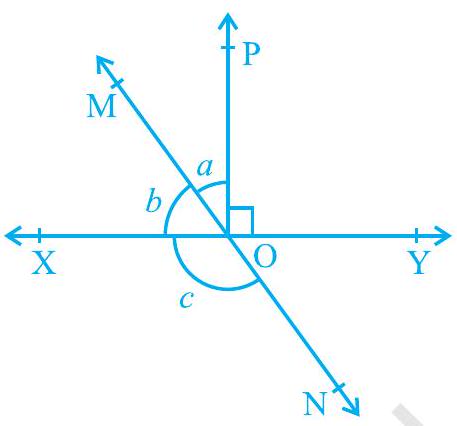
Fig. 6.14
Show Answer
Solution
Let the common ratio between $a$ and $b$ be $x . \quad \therefore$
$X Y$ is a straight line, rays OM and OP stand on it.
$\therefore X O M+MOP+\angle POY=180^{\circ} b+a+POY=180^{\circ}$
$3 x+2 x+90^{\circ}=180^{\circ} 5 x=90^{\circ} x=18^{\circ} a=$
$2 x=2 \times 18=36^{\circ} b=$
$3 x=3 \times 18=54^{\circ}$
MN is a straight line. Ray OX stands on it.
$\therefore b+c=180^{\circ}$ (Linear Pair)
$54^{\circ}+c=180^{\circ} c=180^{\circ}-$
$54^{\circ}=126^{\circ} \quad \therefore c=126^{\circ}$
3. In Fig. 6.15, $\angle \mathrm{PQR}=\angle \mathrm{PRQ}$, then prove that $\angle \mathrm{PQS}=\angle \mathrm{PRT}$.

Fig. 6.15
Show Answer
Solution
In the given figure, ST is a straight line and ray QP stands on it.
$\therefore 4 Q S+P Q R=180^{\circ}$ (Linear Pair)
$\angle PQR=180^{\circ}-\angle PQS(1)$
PRT $+\angle PRQ=180^{\circ}$ (Linear Pair)
${ }^{\angle} PRQ=180^{\circ}-PRT$ (2)
It is given that $4 PQR=\angle PRQ$.
Equating equations (1) and (2), we obtain
$ \begin{aligned} & 180^{\circ}-\stackrel{\angle}{ }{ }^{PQS}=180^{\circ}-PRT \angle PQS \\ & =\angle PRT \end{aligned} $
4. In Fig. 6.16, if $x+y=w+z$, then prove that $\mathrm{AOB}$ is a line.
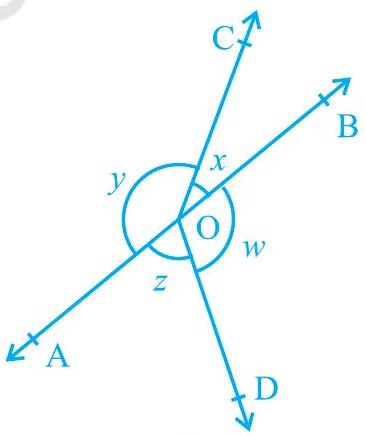
Fig. 6.16
Show Answer
Solution
It can be observed that, $x+y+z+w$ then prove that $A O B$ is a line.
$=360^{\circ}$ (Complete angle) It is given
that, $x+y=z+w \quad \therefore x+y+x+y$
$=360^{\circ}$
$2(x+y)=360^{\circ} x$
$+y=180^{\circ}$
Since $x$ and $y$ form a linear pair, $A O B$ is a line.
5. In Fig. 6.17, $\mathrm{POQ}$ is a line. Ray $\mathrm{OR}$ is perpendicular to line PQ. OS is another ray lying between rays OP and OR. Prove that
$\angle \mathrm{ROS}=\frac{1}{2}(\angle \mathrm{QOS}-\angle \mathrm{POS})$.
Show Answer
Solution
It is given that $OR PQ \quad \perp$
$\therefore \quad \therefore POR=90^{\circ}$
$\therefore \quad \therefore POS+\therefore SOR=90^{\circ}$
$\therefore ROS=90^{\circ}-\therefore POS$.
$\therefore QOR=90^{\circ}$ (As OR $.\therefore PQ)$
$\therefore QOS-\therefore ROS=90^{\circ}$
$\therefore ROS=\therefore QOS-90^{\circ}$
On adding equations (1) and (2), we obtain
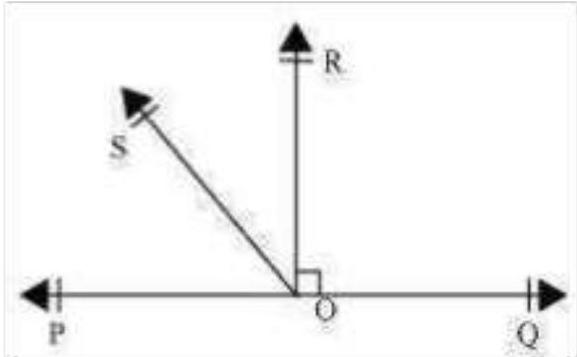
6. It is given that $\angle \mathrm{XYZ}=64^{\circ}$ and $\mathrm{XY}$ is produced to point $\mathrm{P}$. Draw a figure from the given information. If ray $\mathrm{YQ}$ bisects $\angle \mathrm{ZYP}$, find $\angle \mathrm{XYQ}$ and reflex $\angle \mathrm{QYP}$.
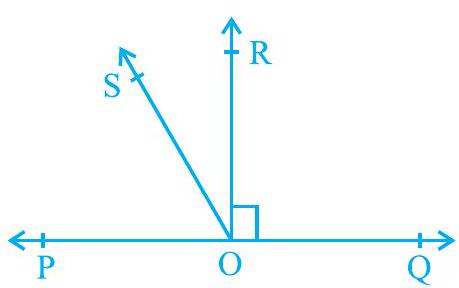
Fig. 6.17
Show Answer
Solution
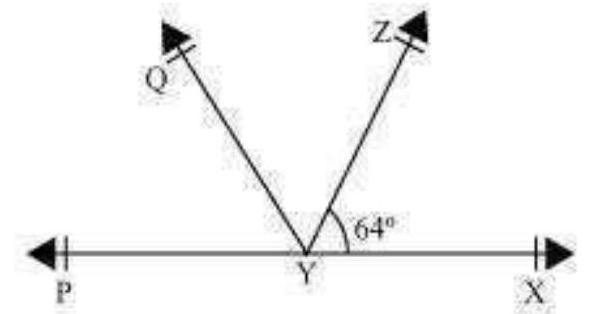
It is given that line YQ bisects $\therefore P Y Z$.
Hence, $\therefore QYP=\therefore ZYQ$
It can be observed that $PX$ is a line. Rays $YQ$ and $YZ$ stand on it.
$\therefore X Y Z+Z Y Q+\therefore Q Y P=180^{\circ}$
$\therefore 64^{\circ}+2 QYP=180^{\circ}$
$\therefore 2$ Q̈PP $=180^{\circ}-64^{\circ}=116^{\circ}$
$\therefore \dot{Q} QP=58^{\circ}$
Also, $\stackrel{\grave{Z}}{ZYQ}=\therefore QYP=58^{\circ}$
Reflex QYP $=360^{\circ}-58^{\circ}=302^{\circ}$
$X Y Q=X Y Z+a Z Y Q$
$=64^{\circ}+58^{\circ}=122^{\circ}$
6.5 Lines Parallel to the Same Line
If two lines are parallel to the same line, will they be parallel to each other? Let us check it. See Fig. 6.18 in which line $m ||$ line $l$ and line $n ||$ line $l$. Let us draw a line $t$ transversal for the lines, $l, m$ and $n$. It is given that line $m ||$ line $l$ and line $n ||$ line $l$.
Therefore, $\angle 1=\angle 2$ and $\angle 1=\angle 3$
(Corresponding angles axiom) So, $\quad \angle 2=\angle 3$ (Why?)
But $\angle 2$ and $\angle 3$ are corresponding angles and they are equal.
Therefore, you can say that
$\text { Line } m || \text { Line } n$
(Converse of corresponding angles axiom)
This result can be stated in the form of the following theorem:

Fig. 6.18
Theorem 6.6 : Lines which are parallel to the same line are parallel to each other.
Note: The property above can be extended to more than two lines also.
Now, let us solve some examples related to parallel lines.
Example 4 : In Fig. 6.19, if $\mathrm{PQ} || \mathrm{RS}, \angle \mathrm{MXQ}=135^{\circ}$ and $\angle \mathrm{MYR}=40^{\circ}$, find $\angle \mathrm{XMY}$.

Fig. 6.19
Solution : Here, we need to draw a line AB parallel to line $\mathrm{PQ}$, through point $\mathrm{M}$ as shown in Fig. 6.20. Now, $A B ||P Q$ and $P Q || R S$.

Fig. 6.20
Therefore, $\quad \quad \quad$$\mathrm{AB} || \mathrm{RS}$ $\quad$(Why?)
Now, $\quad \quad \quad$$\angle \mathrm{QXM}+\angle \mathrm{XMB}=180^{\circ}$
$\quad \quad \quad$(AB ||PQ, Interior angles on the same side of the transversal XM)
But $\quad \quad \quad$$\angle \mathrm{QXM}=135^{\circ}$
So, $\quad \quad \quad$$135^{\circ}+\angle \mathrm{XMB}=180^{\circ}$
Therefore, $\quad \quad \quad$$\angle \mathrm{XMB}=45^{\circ}$ $\quad \quad \quad$(1)
Now,$\quad \quad \quad$$\angle \mathrm{BMY}=\angle \mathrm{MYR}$$\quad$(AB $||$ RS, Alternate angles)
Therefore,$\quad \quad \quad$$\angle \mathrm{BMY}=40^{\circ}$ $\quad \quad \quad$(2)
Adding (1) and (2), you get
$\quad \quad \quad$$\angle \mathrm{XMB}+\angle \mathrm{BMY}=45^{\circ}+40^{\circ}$
That is, $\quad \quad \quad$ $\angle XMY=85^{\circ}$
Example 5 : If a transversal intersects two lines such that the bisectors of a pair of corresponding angles are parallel, then prove that the two lines are parallel.
Solution : In Fig. 6.21, a transversal AD intersects two lines PQ and RS at points B and $\mathrm{C}$ respectively. Ray $\mathrm{BE}$ is the bisector of $\angle \mathrm{ABQ}$ and ray $\mathrm{CG}$ is the bisector of $\angle \mathrm{BCS}$; and $\mathrm{BE} || \mathrm{CG}$.
We are to prove that $\mathrm{PQ} || \mathrm{RS}$.
It is given that ray $\mathrm{BE}$ is the bisector of $\angle \mathrm{ABQ}$.
Therefore, $\quad \angle \mathrm{ABE}=\frac{1}{2} \angle \mathrm{ABQ}$$\quad \quad \quad$(1)
Similarly, ray $\mathrm{CG}$ is the bisector of $\angle \mathrm{BCS}$.
Therefore, $\quad \angle \mathrm{BCG}=\frac{1}{2} \angle \mathrm{BCS}$$\quad \quad \quad$(2)

Fig. 6.21
But $\mathrm{BE} || \mathrm{CG}$ and $\mathrm{AD}$ is the transversal.
Therefore, $\quad \angle \mathrm{ABE}=\angle \mathrm{BCG}$ (Correspondinf angles axioms)$\quad \quad \quad$(3)
Substituting (1) and (2) in (3), you get
$$\frac{1}{2} \angle \mathrm{ABQ}=\frac{1}{2} \angle \mathrm{BCS}$$
That is, $\quad$$\angle \mathrm{ABQ}=\angle \mathrm{BCS}$
But, they are the corresponding angles formed by transversal AD with PQ and RS; and are equal.
Therefore,
PQ $||$ RS
(Converse of corresponding angles axiom)
Example 6 : In Fig. 6.22, $\mathrm{AB} || \mathrm{CD}$ and $\mathrm{CD} || \mathrm{EF}$. Also $\mathrm{EA} \perp \mathrm{AB}$. If $\angle \mathrm{BEF}=55^{\circ}$, find the values of $x, y$ and $z$.
Solution : $y+55^{\circ}=180^{\circ}$
(Interior angles on the same side of the transversal ED)
Therefore, $\quad$ $y=180^{\circ}-55^{\circ}=125^{\circ}$
Again $\quad \quad \quad$$x=y$
$\quad \quad$( $\mathrm{AB} || \mathrm{CD}$, Corresponding angles axiom)
Therefore $\quad \quad$$x=125^{\circ}$
Now, since $\mathrm{AB} || \mathrm{CD}$ and $\mathrm{CD} || \mathrm{EF}$, therefore, $\mathrm{AB} || \mathrm{EF}$.

Fig. 6.22
So, $\quad \quad$$\angle \mathrm{EAB}+\angle \mathrm{FEA}=180^{\circ}$(Interior angles on the same side of the transversal EA)
Therefore, $\quad$$90^{\circ}+z+55^{\circ}=180^{\circ}$
Which gives $\quad$$z=35^{\circ}$
EXERCISE 6.2
1. In Fig. 6.23, if $\mathrm{AB}||\mathrm{CD}, \mathrm{CD}|| \mathrm{EF}$ and $y: z=3: 7$, find $x$.

Fig. 6.23
Show Answer
Solution
It is given that $A B | C D$ and $C D | E F$
$\therefore A B | C D|| E F$ (Lines parallel to the same line are parallel to each other) It can be observed that $x=z$
(Alternate interior angles) … (1)
It is given that $y: z=3: 7$
Let the common ratio between $y$ and $z$ be $a$. $\therefore$
$y=3 a$ and $z=7 a$
Also, $x+y=180^{\circ}$ (Co-interior angles on the same side of the transversal) $z$
$+y=180^{\circ}$ [Using equation (1)]
$7 a+3 a=180^{\circ}$
$10 a=180^{\circ} a=$
$18^{\circ} \therefore x=7 a=7 \times 18^{\circ}=$
2. In Fig. 6.24, if $\mathrm{AB} || \mathrm{CD}, \mathrm{EF} \perp \mathrm{CD}$ and $\angle \mathrm{GED}=126^{\circ}$, find $\angle \mathrm{AGE}, \angle \mathrm{GEF}$ and $\angle \mathrm{FGE}$.
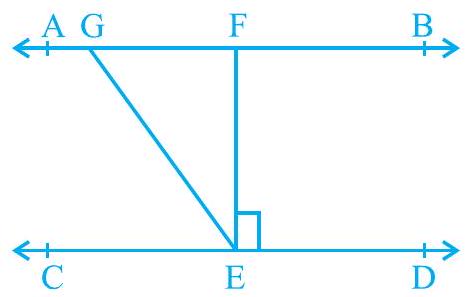
Fig. 6.24
Show Answer
Solution
It is given that, $A B | C D$
EF CD
$\therefore GED=126^{\circ}$
$\therefore \therefore$ GEF $+\therefore F E D=1260$
$\therefore \quad GEF+90^{\circ}=126^{\circ}$
$\therefore \therefore \quad GEF=36^{\circ}$
$\therefore \quad$ AGE and GED are alternate interior angles.
$\therefore \quad \therefore \quad$ AGE $=$ GED $=126^{\circ}$
Howềver, $AGÉ+FGE=180^{\circ}$ (Linear pair)
$\therefore \quad 1260^{\circ}+FGE=180^{\circ}$
$\therefore \quad \therefore \quad FGE=180^{\circ}-126^{\circ}=54^{\circ}$
$AGE=126^{\circ}, \therefore GEF=36^{\circ}, \therefore FGE=54^{\circ}$
3. In Fig. 6.25, if $\mathrm{PQ} || \mathrm{ST}, \angle \mathrm{PQR}=110^{\circ}$ and $\angle \mathrm{RST}=130^{\circ}$, find $\angle \mathrm{QRS}$.
[Hint : Draw a line parallel to ST through point R.]
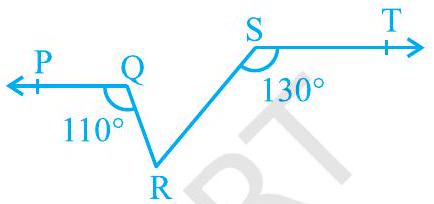
Fig. 6.25
Show Answer
Solution
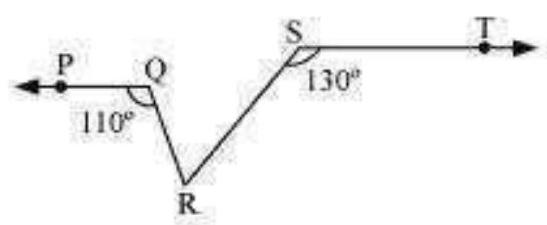
Let us draw a line XY parallel to ST and passing through point $R$. $\therefore PQR+QRX=180^{\circ}$ (Co-interior angles on the same side of transversal QR)
$\therefore 110^{\circ}+Q R X=180^{\circ}$
$\therefore QRX=70^{\circ}$
Also,
$\therefore RST+\therefore$ SRY $=180^{\circ}$ (Co-interior angles on the same side of transversal SR) $0+S R Y=180^{\circ} 130$
$\therefore SRY=50^{\circ}$
$XY$ is a straight line. RQ and RS stand on it.
$\therefore \therefore QRX+\therefore QRS+\therefore SRY=180^{\circ} \circ+QRS+50^{\circ}=180^{\circ} 70$
$QRS=180^{\circ}-120^{\circ}=60^{\circ}$
$\therefore$
4. In Fig. 6.26, if $\mathrm{AB} || \mathrm{CD}, \angle \mathrm{APQ}=50^{\circ}$ and $\angle \mathrm{PRD}=127^{\circ}$, find $x$ and $y$.
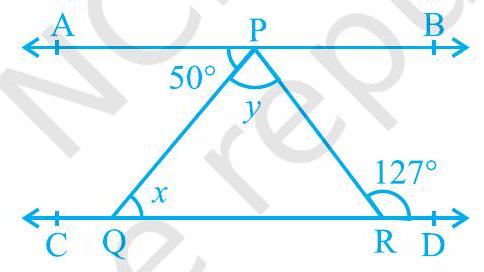
Fig. 6.26
Show Answer
Solution
$\therefore APR=\therefore PRD$ (Alternate interior angles) In the given figure, if $AB | CD, APQ=50^{\circ}$ and $\therefore$ $P R D=1270$, find $x$ and $y$.
$50^{\circ}+y=127^{\circ} y=$
$127^{\circ}-50^{\circ} y=$
770
Also, $A P Q=P Q R$ (Alternate interior angles)
$50^{\circ}=x \quad x=50^{\circ}$ and $y=770$
5. In Fig. 6.27, PQ and RS are two mirrors placed parallel to each other. An incident ray $\mathrm{AB}$ strikes the mirror $\mathrm{PQ}$ at $\mathrm{B}$, the reflected ray moves along the path $\mathrm{BC}$ and strikes the mirror $\mathrm{RS}$ at $\mathrm{C}$ and again reflects back along $\mathrm{CD}$. Prove that $\mathrm{AB} || \mathrm{CD}$.
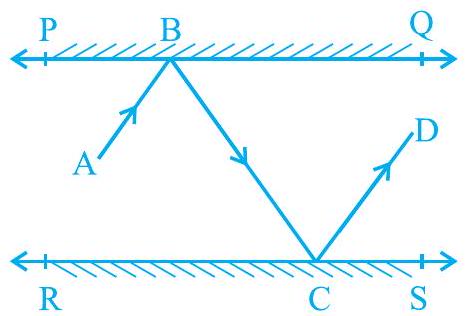
Fig. 6.27
Show Answer
Solution
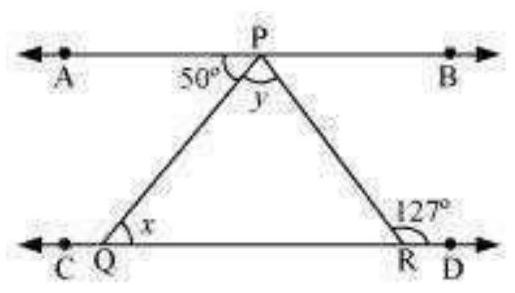
Let us draw $BM \therefore PQ$ and $CN \therefore RS$.
As PQ || RS,
Therefore, BM || CN
Thus, $BM$ and $CN$ are two parallel lines and a transversal line $BC$ cuts them at $B$ and
C respectively.
$\therefore A=3$ (Alternate interior angles) 2
However, $1=2$ and $3=* 4$ (By"laws of reflection)
$\therefore 1=2 \doteq 3=4$
Also, $\dot{1}+2 \stackrel{\dot{\circ}}{=} 3+\dot{4}$
$\therefore ABC=\ddot{DCB}$
However, these are alternate interior angles. :
$A B|| C D$
6.6 Summary
In this chapter, you have studied the following points:
1. If a ray stands on a line, then the sum of the two adjacent angles so formed is $180^{\circ}$ and viceversa. This property is called as the Linear pair axiom.
2. If two lines intersect each other, then the vertically opposite angles are equal.
3. Lines which are parallel to a given line are parallel to each other.
6.1 भूमिका
अध्याय 5 में, आप पढ़ चुके हैं कि एक रेखा को खींचने के लिए न्यूनतम दो बिंदुओं की आवश्यकता होती है। आपने कुछ अभिगृहीतों (axioms) का भी अध्ययन किया है और उनकी सहायता से कुछ अन्य कथनों को सिद्ध किया है। इस अध्याय में, आप कोणों के उन गुणों का अध्ययन करेंगे जब दो रेखाएँ परस्पर प्रतिच्छेद करती हैं और कोणों के उन गुणों का भी अध्ययन करेंगे जब एक रेखा दो या अधिक समांतर रेखाओं को भिन्न-भिन्न बिंदुओं पर काटती है। साथ ही, आप इन गुणों का निगमनिक तर्कण (deductive reasoning) द्वारा कुछ कथनों को सिद्ध करने में भी प्रयोग करेंगे (देखिए परिशिष्ट 1)। आप पिछली कक्षाओं में इन कथनों की कुछ क्रियाकलापों द्वारा जाँच (पुष्टि) कर चुके हैं।
आप अपने दैनिक जीवन में समतल पृष्ठों के किनारों (edges) के बीच बने अनेक प्रकार के कोण देखते हैं। समतल पृष्ठों का प्रयोग करके, एक ही प्रकार के मॉडल बनाने के लिए, आपको कोणों के बारे में विस्तृत जानकारी की आवश्यकता होती है। उदाहरणार्थ, आप अपने विद्यालय की प्रदर्शिनी के लिए बाँसों का प्रयोग करके एक झोंपड़ी का मॉडल बनाना चाहते हैं। सोचिए, आप इसे कैसे बनाएँगे। कुछ बाँसों को आप परस्पर समांतर रखेंगे और कुछ को तिरछा रखेंगे। जब एक आर्किटेक्ट (architect) एक बहुतलीय भवन के लिए एक रेखाचित्र खींचता है, तो उसे विभिन्न कोणों पर प्रतिच्छेदी और समांतर रेखाएँ खींचनी पड़ती हैं। क्या आप सोचते हैं कि वह रेखाओं और कोणों के ज्ञान के बिना इस भवन की रूपरेखा खींच सकता है?
विज्ञान में, आप प्रकाश के गुणों का किरण आरेख (ray diagrams) खींच कर अध्ययन करते हैं। उदाहरणार्थ, प्रकाश के अपवर्तन (refraction) गुण का अध्ययन करने के लिए, जब प्रकाश की किरणें एक माध्यम (medium) से दूसरे माध्यम में प्रवेश करती हैं, आप प्रतिच्छेदी रेखाओं और समांतर रेखाओं के गुणों का प्रयोग करते हैं। जब एक पिंड पर दो या अधिक बल कार्य कर रहे हों, तो आप इन बलों का उस पिंड पर परिणामी बल ज्ञात करने के लिए, एक ऐसा आरेख खींचते हैं जिसमें बलों को दिष्ट रेखाखंडों (directed line segments) द्वारा निरूपित किया जाता है। उस समय, आपको उन कोणों के बीच संबंध जानने की आवश्यकता होगी जिनकी किरणें (अथवा रेखाखंड) परस्पर समांतर या प्रतिच्छेदी होंगी। एक मीनार की ऊँचाई ज्ञात करने अथवा किसी जहाज की एक प्रकाश पुंज (light house) से दूरी ज्ञात करने के लिए, हमें क्षैतिज और दृष्टि रेखा (line of sight) के बीच बने कोण की जानकारी की आवश्यकता होगी। प्रचुर मात्रा में ऐसे उदाहरण दिए जा सकते हैं जहाँ रेखाओं और कोणों का प्रयोग किया जाता है। ज्यामिति के आने वाले अध्यायों में, आप रेखाओं और कोणों के इन गुणों का अन्य उपयोगी गुणों को निगमित (निकालने) करने में प्रयोग करेंगे।
आइए पहले हम पिछली कक्षाओं में रेखाओं और कोणों से संबंधित पढ़े गए पदों और परिभाषाओं का पुनर्विलोकन करें।
6.2 आधारभूत पद और परिभाषाएँ
याद कीजिए कि एक रेखा का वह भाग जिसके दो अंत बिंदु हों एक रेखाखंड कहलाता है और रेखा का वह भाग जिसका एक अंत बिंदु हो एक किरण कहलाता है। ध्यान दीजिए कि रेखाखंड $\mathrm{AB}$ को $\overline{\mathrm{AB}}$ से व्यक्त किया जाता है और उसकी लंबाई को $\mathrm{AB}$ से व्यक्त किया जाता है। किरण $\mathrm{AB}$ को $\overrightarrow{\mathrm{AB}}$ से और रेखा $\mathrm{AB}$ को $\overleftrightarrow{\mathrm{AB}}$ से व्यक्त किया जाता है। परन्तु हम इन संकेतनों का प्रयोग नहीं करेंगे तथा रेखा $\mathrm{AB}$, किरण $\mathrm{AB}$, रेखाखंड $\mathrm{AB}$ और उसकी लंबाई को एक ही संकेत $\mathrm{AB}$ से व्यक्त करेंगे। इनका अर्थ संदर्भ से स्पष्ट हो जाएगा। कभी-कभी छोटे अक्षर जैसे $l, m, n$ इत्यादि का प्रयोग रेखाओं को व्यक्त करने में किया जाएगा।
यदि तीन या अधिक बिंदु एक ही रेखा पर स्थित हों, तो वे संरेख बिंदु (collinear points) कहलाते हैं, अन्यथा वे असंरेख बिंदु (non-collinear points) कहलाते हैं।
याद कीजिए कि जब दो किरणें एक ही अंत बिंदु से प्रारम्भ होती हैं, तो एक कोण (angle) बनता है। कोण को बनाने वाली दोनों किरणें कोण की भुजाएँ (arms या sides) कहलाती हैं और वह उभयनिष्ठ अंत बिंदु कोण का शीर्ष (vertex) कहलाता है। आप पिछली कक्षाओं में, विभिन्न प्रकार के कोणों जैसे न्यून कोण (acute angle), समकोण (right angle), अधिक कोण (obtuse angle), ॠजु कोण (straight angle) और प्रतिवर्ती कोण (reflex angle) के बारे में पढ़ चुके हैं (देखिए आकृति 6.1)।

आकृति 6.1 : कोणों के प्रकार
एक न्यून कोण का माप $0^{\circ}$ और $90^{\circ}$ के बीच होता है, जबकि एक समकोण का माप ठीक $90^{\circ}$ होता है। $90^{\circ}$ से अधिक परन्तु $180^{\circ}$ से कम माप वाला कोण अधिक कोण कहलाता है। साथ ही, याद कीजिए कि एक ऋजु कोण $180^{\circ}$ के बराबर होता है। वह कोण जो $180^{\circ}$ से अधिक, परन्तु $360^{\circ}$ से कम माप का होता है एक प्रतिवर्ती कोण कहलाता है। इसके अतिरिक्त, यदि दो कोणों का योग एक समकोण के बराबर हो, तो ऐसे कोण पूरक कोण (complementary angles) कहलाते हैं और वे दो कोण, जिनका योग $180^{\circ}$ हो, संपूरक कोण (supplementary angles) कहलाते हैं।
आप पिछली कक्षाओं में आसन्न कोणों (adjacent angles) के बारे में भी पढ़ चुके हैं (देखिए आकृति 6.2)। दो कोण आसन्न कोण (adjacent angles) कहलाते हैं, यदि उनमें एक उभयनिष्ठ शीर्ष हो, एक उभयनिष्ठ भुजा हो और उनकी वे भुजाएँ जो उभयनिष्ठ नहीं हैं, उभयनिष्ठ भुजा के विपरीत ओर स्थित हों। आकृति 6.2 में, $\angle \mathrm{ABD}$ और $\angle \mathrm{DBC}$ आसन्न कोण हैं। किरण $\mathrm{BD}$ इनकी उभयनिष्ठ भुजा है और $\mathrm{B}$ इनका उभयनिष्ठ शीर्ष है। किरण $\mathrm{BA}$ और किरण $\mathrm{BC}$ वे भुजाएँ हैं जो उभयनिष्ठ नहीं हैं। इसके अतिरिक्त, जब दो कोण आसन्न कोण होते हैं, तो उनका योग उस कोण के बराबर होता है जो इनकी उन भुजाओं से बनता है, जो उभयनिष्ठ नहीं हैं।

आकृति 6.2 : आसन्न कोण अतः हम लिख सकते हैं कि
$\angle \mathrm{ABC}=\angle \mathrm{ABD}+\angle \mathrm{DBC}$ है।
ध्यान दीजिए कि $\angle \mathrm{ABC}$ और $\angle \mathrm{ABD}$ आसन्न कोण नहीं हैं। क्यों? इसका कारण यह है कि अउभयनिष्ठ भुजाएँ (अर्थात् वे भुजाएँ जो उभयनिष्ठ नहीं हैं) $\mathrm{BD}$ और $\mathrm{BC}$ उभयनिष्ठ भुजा $\mathrm{BA}$ के एक ही ओर स्थित है।
यदि आकृति 6.2 में, अउभयनिष्ठ भुजाएँ $\mathrm{BA}$ और $\mathrm{BC}$ एक रेखा बनाएँ, तो यह आकृति 6.3 जैसा कोणों का रैखिक युग्म लगेगा। इस स्थिति में, $\angle \mathrm{ABD}$ और $\angle \mathrm{DBC}$ कोणों का एक रैखिक युग्म (linear pair of angles) बनाते हैं।

आकृति 6.3 : कोणों का रैखिक युग्म
आप शीर्षाभिमुख कोणों (vertically opposite angles) को भी याद कर सकते हैं, जो दो रेखाओं, मान लीजिए, $\mathrm{AB}$ और $\mathrm{CD}$ को परस्पर बिंदु $\mathrm{O}$ पर प्रतिच्छेद करने पर बनते हैं (देखिए आकृति 6.4)। यहाँ शीर्षाभिमुख कोणों के दो युग्म हैं।

आकृति 6.4 : शीर्षाभिमुख कोण युग्म
इनमें से एक शीर्षाभिमुख कोण युग्म $\angle \mathrm{AOD}$ और $\angle \mathrm{BOC}$ का है। क्या आप दूसरा युग्म ज्ञात कर सकते हैं?
6.3 प्रतिच्छेदी रेखाएँ और अप्रतिच्छेदी रेखाएँ
एक कागज़ पर दो भिन्न रेखाएँ $\mathrm{PQ}$ और $\mathrm{RS}$ खींचिए। आप देखेंगे कि आप इन रेखाओं को दो प्रकार से खींच सकते हैं, जैसा कि आकृति 6.5 (i) और आकृति 6.5 (ii) में दर्शाया गया है।

आकृति 6.5 : दो रेखाएँ खींचने के विभिन्न प्रकार
(ii) अप्रतिच्छेदी (समांतर) रेखाएँ रेखा की इस अवधारणा को भी याद कीजिए कि वह दोनों दिशाओं में अनिश्चित रूप से विस्तृत होती है। रेखाएँ $\mathrm{PQ}$ और $\mathrm{RS}$ आकृति 6.5 (i) में प्रतिच्छेदी रेखाएँ हैं और आकृति 6.5 (ii) में ये समांतर रेखाएँ हैं। ध्यान दीजिए कि इन दोनों समांतर रेखाओं के विभिन्न बिंदुओं पर उनके उभयनिष्ठ लम्बों की लंबाइयाँ समान रहेंगी। यह समान लंबाई दोनों समांतर रेखाओं के बीच की दूरी कहलाती है।
6.4 कोणों के युग्म
अनुच्छेद 6.2 में, आप कोणों के कुछ युग्मों जैसे पूरक कोण, संपूरक कोण, आसन्न कोण, कोणों का रैखिक युग्म, इत्यादि की परिभाषाओं के बारे में पढ़ चुके हैं। क्या आप इन कोणों में किसी संबंध के बारे में सोच सकते हैं? आइए अब उन कोणों में संबंध पर विचार करें जिन्हें कोई किरण किसी रेखा पर स्थित होकर बनाती है, जैसा कि आकृति 6.6 में दर्शाया गया है। रेखा को $\mathrm{AB}$ और किरण को $\mathrm{OC}$ कहिए। बिंदु $\mathrm{O}$ पर बनने वाले कोण क्या हैं? ये कोणों का रैखिक युग्म $\angle \mathrm{AOC}, \angle \mathrm{BOC}$ और $\angle \mathrm{AOB}$ हैं।

आकृति 6.6 :
क्या हम $\angle \mathrm{AOC}+\angle \mathrm{BOC}=\angle \mathrm{AOB}$ लिख सकते हैं? (1)
हाँ! (क्यों? अनुच्छेद 6.2 में दिए आसन्न कोणों को देखिए।)
$\angle \mathrm{AOB}$ का माप क्या है? यह $180^{\circ}$ है। (क्यों?) (2)
क्या (1) ओर (2) से, आप कह सकते हैं कि $\angle \mathrm{AOC}+\angle \mathrm{BOC}=180^{\circ}$ है? हाँ! (क्यों?)
उपरोक्त चर्चा के आधार पर, हम निम्न अभिगृहीत को लिख सकते हैं:
अभिगृहीत 6.1 : यदि एक किरण एक रेखा पर खड़ी हो, तो इस प्रकार बने दोनों आसन्न कोणों का योग $180^{\circ}$ होता है।
याद कीजिए कि जब दो आसन्न कोणों का योग $180^{\circ}$ हो, तो वे कोणों का एक रैखिक युग्म बनाते हैं।
अभिगृहीत 6.1 में यह दिया है कि ‘एक किरण एक रेखा पर खड़ी हो’। इस दिए हुए से, हमने निष्कर्ष निकाला कि इस प्रकार बने दोनों आसन्न कोणों का योग $180^{\circ}$ होता है। क्या हम अभिगृहीत 6.1 को एक विपरीत प्रकार से लिख सकते हैं? अर्थात् अभिगृहीत 6.1 के निष्कर्ष को दिया हुआ मानें और उसके दिए हुए को निष्कर्ष मानें। तब हमें यह प्राप्त होगा:
(A) यदि दो आसन्न कोणों का योग $180^{\circ}$ है, तो एक किरण एक रेखा पर खड़ी होती है (अर्थात् अउभयनिष्ठ भुजाएँ एक ही रेखा में हैं)।
अब आप देखते हैं कि अभिगृहीत 6.1 और कथन (A) एक दूसरे के विपरीत हैं। हम इनमें से प्रत्येक को दूसरे का विलोम (converse) कहते हैं। हम यह नहीं जानते कि कथन (A) सत्य है या नहीं। आइए इसकी जाँच करें। विभिन्न मापों के, आकृति 6.7 में दर्शाए अनुसार, आसन्न कोण खींचिए। प्रत्येक स्थिति में, अउभयनिष्ठ भुजाओं में से एक भुजा के अनुदिश एक पटरी (ruler) रखिए। क्या दूसरी भुजा भी इस पटरी के अनुदिश स्थित है?

आकृति 6.7 : विभिन्न मापों के आसन्न कोण
आप पाएँगे कि केवल आकृति 6.7 (iii) में ही दोनों अउभयनिष्ठ भुजाएँ पटरी के अनुदिश हैं, अर्थात् $\mathrm{A}, \mathrm{O}$ और $\mathrm{B}$ एक ही रेखा पर स्थित हैं और किरण $\mathrm{OC}$ इस रेखा पर खड़ी है। साथ ही, यह भी देखिए कि $\angle \mathrm{AOC}+\angle \mathrm{COB}=125^{\circ}+55^{\circ}=180^{\circ}$ है। इससे आप निष्कर्ष निकाल सकते हैं कि कथन (A) सत्य है। अतः, आप इसे एक अभिगृहीत के रूप में निम्न प्रकार लिख सकते हैं :
अभिगृहीत 6.2 : यदि दो आसन्न कोणों का योग $180^{\circ}$ है, तो उनकी अउभयनिष्ठ भुजाएँ एक रेखा बनाती हैं।
स्पष्ट कारणों से, उपरोक्त दोनों अभिगृहीतों को मिला कर रैखिक युग्म अभिगृहीत (Linear Pair Axiom) कहते हैं।
आइए अब उस स्थिति की जाँच करें जब दो रेखाएँ प्रतिच्छेद करती हैं।
पिछली कक्षाओं से आपको याद होगा कि यदि दो रेखाएँ परस्पर प्रतिच्छेद करें, तो शीर्षाभिमुख कोण बराबर होते हैं। आइए अब इस परिणाम को सिद्ध करें। एक उपपत्ति (proof) में निहित अवयवों के लिए, परिशिष्ट 1 को देखिए और नीचे दी हुई उपपत्ति को पढ़ते समय इन्हें ध्यान में रखिए।
प्रमेय 6.1 : यदि दो रेखाएँ परस्पर प्रतिच्छेद करती हैं, तो शीर्षाभिमुख कोण बराबर होते हैं।
उपपत्ति : उपरोक्त कथन में यह दिया है कि दो रेखाएँ परस्पर प्रतिच्छेद करती हैं। अतः मान लीजिए कि $\mathrm{AB}$ और $\mathrm{CD}$ दो रेखाएँ हैं जो परस्पर बिंदु $\mathrm{O}$ पर प्रतिच्छेद करती हैं, जैसा कि आकृति 6.8 में दर्शाया गया है। इससे हमें शीर्षाभिमुख कोणों के निम्न दो युग्म प्राप्त होते हैं:
(i) $\angle \mathrm{AOC}$ और $\angle \mathrm{BOD}$ (ii) $\angle \mathrm{AOD}$ और $\angle \mathrm{BOC}$

आकृति 6.8 : शीर्षाभिमुख कोण
हमें सिद्ध करना है कि $\angle \mathrm{AOC}=\angle \mathrm{BOD}$ है
और $\angle \mathrm{AOD}=\angle \mathrm{BOC}$ है।
अब किरण $\mathrm{OA}$ रेखा $\mathrm{CD}$ पर खड़ी है।
अत: $\angle \mathrm{AOC}+\angle \mathrm{AOD}=180^{\circ}$
क्या हम $\angle \mathrm{AOD}+\angle \mathrm{BOD}=180^{\circ}$ लिख सकते हैं? हाँ। (क्यों?)
(1) और (2) से, हम लिख सकते हैं कि:
$$ \angle \mathrm{AOC}+\angle \mathrm{AOD}=\angle \mathrm{AOD}+\angle \mathrm{BOD} $$
इससे निष्कर्ष निकलता है कि $\angle \mathrm{AOC}=\angle \mathrm{BOD}$ (अनुच्छेद 5.2 का अभिगृहीत 3 देखिए)
इसी प्रकार, सिद्ध किया जा सकता है कि $\angle \mathrm{AOD}=\angle \mathrm{BOC}$ है।
आइए अब रैखिक युग्म अभिगृहीत और प्रमेय 6.1 पर आधारित कुछ उदाहरण हल करें।
उदाहरण 1 : आकृति 6.9 में, रेखाएँ $\mathrm{PQ}$ और RS परस्पर बिंदु $\mathrm{O}$ पर प्रतिच्छेद करती हैं। यदि $\angle \mathrm{POR}: \angle \mathrm{ROQ}$ $=5: 7$ है, तो सभी कोण ज्ञात कीजिए।
हल : $\angle \mathrm{POR}+\angle \mathrm{ROQ}=180^{\circ}$
(रैखिक युग्म के कोण)
परन्तु, $\angle \mathrm{POR}: \angle \mathrm{ROQ}=5: 7$ (दिया है)
अतः, $\quad \angle \mathrm{POR}=\frac{5}{12} \times 180^{\circ}=75^{\circ}$

इसी प्रकार, $\quad \angle \mathrm{ROQ}=\frac{7}{12} \times 180^{\circ}=105^{\circ}$
$$\begin{aligned} & \angle \mathrm{POS}=\angle \mathrm{ROQ}=105^{\circ} \\ & \angle \mathrm{SOQ}=\angle \mathrm{POR}=75^{\circ} \end{aligned}$$
उदाहरण 2 : आकृति 6.10 में, किरण $\mathrm{OS}$ रेखा $\mathrm{POQ}$ पर खड़ी है। किरण OR और OT क्रमशः $\angle \mathrm{POS}$ और $\angle \mathrm{SOQ}$ के समद्विभाजक हैं। यदि $\angle \mathrm{POS}=x$ है, तो $\angle \mathrm{ROT}$ ज्ञात कीजिए।
हल : किरण OS रेखा POQ पर खड़ी है।
अत:,
$\angle \mathrm{POS}+\angle \mathrm{SOQ}=180^{\circ}$
परन्तु,
$$ \angle \mathrm{POS}=x $$
अतः,
$x+\angle \mathrm{SOQ}=180^{\circ}$ $\angle \mathrm{SOQ}=180^{\circ}-x$
इसलिए, अब किरण $\mathrm{OR}, \angle \mathrm{POS}$ को समद्विभाजित करती है।

आकृति 6.10
$$ \begin{aligned} \angle \mathrm{ROS} & =\frac{1}{2} \times \angle \mathrm{POS} \\ & =\frac{1}{2} \times x=\frac{x}{2} \end{aligned} $$
इसी प्रकार,
$$ \begin{aligned} \angle \mathrm{SOT} & =\frac{1}{2} \times \angle \mathrm{SOQ} \\ & =\frac{1}{2} \times\left(180^{\circ}-x\right) \\ & =90^{\circ}-\frac{x}{2} \end{aligned} $$
अब,
$$ \begin{aligned} \angle \mathrm{ROT} & =\angle \mathrm{ROS}+\angle \mathrm{SOT} \\ & =\frac{x}{2}+90^{\circ}-\frac{x}{2} \\ & =90^{\circ} \end{aligned} $$
उदाहरण 3 : आकृति 6.11 में, $\mathrm{OP}, \mathrm{OQ}, \mathrm{OR}$ और $\mathrm{OS}$ चार किरणें हैं। सिद्ध कीजिए कि $\angle \mathrm{POQ}+\angle \mathrm{QOR}+$ $\angle \mathrm{SOR}+\angle \mathrm{POS}=360^{\circ}$ है।
हल : आकृति 6.11 में, आपको किरणों $\mathrm{OP}, \mathrm{OQ}, \mathrm{OR}$ और $\mathrm{OS}$ में से किसी एक को पीछे एक बिंदु तक बढ़ाए जाने की आवश्यकता है। आइए किरण $\mathrm{OQ}$ को एक बिंदु $T$ तक पीछे बढ़ा दें ताकि TOQ एक रेखा

आकृति 6.11 हो (देखिए आकृति 6.12)।
अब किरण $\mathrm{OP}$ रेखा TOQ पर खड़ी है।
अत:,
$\quad \angle \mathrm{TOP}+\angle \mathrm{POQ}=180^{\circ}$
(रैखिक युग्म अभिगृहीत)
इसी प्रकार, किरण OS रेखा TOQ पर खड़ी है।
अतः,
$\angle \mathrm{TOS}+\angle \mathrm{SOQ}=180^{\circ}$
परन्तु $\angle \mathrm{SOQ}=\angle \mathrm{SOR}+\angle \mathrm{QOR}$ है।
अतः,(2) निम्न हो जाती है :

आकृति 6.12
$$ \begin{equation*} \angle \mathrm{TOS}+\angle \mathrm{SOR}+\angle \mathrm{QOR}=180^{\circ} \tag{3} \end{equation*} $$
अब, (1) और (3) को जोड़ने पर, आपको प्राप्त होगा:
$$ \begin{equation*} \angle \mathrm{TOP}+\angle \mathrm{POQ}+\angle \mathrm{TOS}+\angle \mathrm{SOR}+\angle \mathrm{QOR}=360^{\circ} \tag{4} \end{equation*} $$
परन्तु
$\angle \mathrm{TOP}+\angle \mathrm{TOS}=\angle \mathrm{POS}$ है।
अतः,(4) निम्न हो जाती है :
$$ \angle \mathrm{POQ}+\angle \mathrm{QOR}+\angle \mathrm{SOR}+\angle \mathrm{POS}=360^{\circ} $$
प्रश्नावली 6.1
1. आकृति 6.13 में, रेखाएँ $\mathrm{AB}$ और $\mathrm{CD}$ बिंदु $\mathrm{O}$ पर प्रतिच्छेद करती हैं। यदि $\angle \mathrm{AOC}+\angle \mathrm{BOE}=70^{\circ}$ है और $\angle \mathrm{BOD}=40^{\circ}$ है, तो $\angle \mathrm{BOE}$ और प्रतिवर्ती $\angle \mathrm{COE}$ ज्ञात कीजिए।

आकृति 6.13
Show Answer
Missing2. आकृति 6.14 में, रेखाएँ $\mathrm{XY}$ और $\mathrm{MN}$ बिंदु $\mathrm{O}$ पर प्रतिच्छेद करती हैं। यदि $\angle \mathrm{POY}=90^{\circ}$ और $a: b=2: 3$ है, तो $c$ ज्ञात कीजिए।

आकृति 6.14
Show Answer
Missing3. आकृति 6.15 में, यदि $\angle \mathrm{PQR}=\angle \mathrm{PRQ}$ है, तो सिद्ध कीजिए कि $\angle \mathrm{PQS}=\angle \mathrm{PRT}$ है।

आकृति 6.15
Show Answer
Missing4. आकृति 6.16 में, यदि $x+y=w+z$ है, तो सिद्ध कीजिए कि $\mathrm{AOB}$ एक रेखा है।

आकृति 6.16
Show Answer
Missing5. आकृति 6.17 में, $\mathrm{POQ}$ एक रेखा है। किरण $\mathrm{OR}$ रेखा $\mathrm{PQ}$ पर लम्ब है। किरणों $\mathrm{OP}$ और $\mathrm{OR}$ के बीच में $\mathrm{OS}$ एक अन्य किरण है। सिद्ध कीजिए:
$\angle \mathrm{ROS}=\frac{1}{2}(\angle \mathrm{QOS}-\angle \mathrm{POS})$
Show Answer
Missing6. यह दिया है कि $\angle \mathrm{XYZ}=64^{\circ}$ है और $\mathrm{XY}$ को बिंदु $\mathrm{P}$ तक बढ़ाया गया है। दी हुई सूचना से एक आकृति खींचिए। यदि किरण $\mathrm{YQ}, \angle \mathrm{ZYP}$ को समद्विभाजित करती है, तो $\angle \mathrm{XYQ}$ और प्रतिवर्ती $\angle \mathrm{QYP}$ के मान ज्ञात कीजिए।

आकृति 6.17
Show Answer
Missing6.5 एक ही रेखा के समांतर रेखाएँ
यदि दो रेखाएँ एक ही रेखा के समांतर हों, तो क्या वे परस्पर समांतर होंगी? आइए इसकी जाँच करें। आकृति 6.18 को देखिए, जिसमें $m | l$ है और $n | l$ है। आइए रेखाओं $l, m$ और $n$ के लिए एक तिर्यक रेखा $t$ खींचें। यह दिया है कि $m | l$ है और $n | l$ है।
अत: $\angle 1=\angle 2$ और $\angle 1=\angle 3$ है। (संगत कोण अभिगृहीत)
इसलिए, $\angle 2=\angle 3$ (क्यों?)
परन्तु $\angle 2$ और $\angle 3$ संगत कोण हैं और बराबर हैं।
अतः, आप कह सकते हैं कि
$m || n $
(संगत कोण अभिगृहीत का विलोम)
इस परिणाम को एक प्रमेय के रूप में निम्न प्रकार व्यक्त किया जा सकता है:

आकृति 6.18
प्रमेय 6.6 : वे रेखाएँ जो एक ही रेखा के समांतर हों, परस्पर समांतर होती हैं।
टिप्पणी: उपरोक्त गुण को दो से अधिक रेखाओं के लिए भी लागू किया जा सकता है।
आइए अब समांतर रेखाओं से संबंधित कुछ प्रश्न हल करें:
उदाहरण 4 : आकृति 6.19 में, यदि $\mathrm{PQ} | \mathrm{RS}, \angle \mathrm{MXQ}=135^{\circ}$ और $\angle \mathrm{MYR}=40^{\circ}$ है, तो $\angle \mathrm{XMY}$ ज्ञात कीजिए।

आकृति 6.19
हल : यहाँ हमें $m$ से होकर, रेखा $\mathrm{PQ}$ के समांतर एक रेखा $\mathrm{AB}$ खींचने की आवश्यकता है, जैसा कि आकृति 6.20 में दिखाया गया है। अब, $\mathrm{AB} || \mathrm{PQ}$ और $\mathrm{PQ} || \mathrm{RS}$ है। अतः,

आकृति 6.20
$\mathrm{AB} || \mathrm{RS}$ है। (क्यों?)
अब, $\angle \mathrm{QXM}+\angle \mathrm{XMB}=180^{\circ}$
$(\mathrm{AB} || \mathrm{PQ}$, तिर्यक रेखा $\mathrm{XM}$ के एक ही ओर के अंतः कोण)
परन्तु, $\angle \mathrm{QXM}=135^{\circ} \text { है। इसलिए, }$
$$ \begin{equation*} 135^{\circ}+\angle \mathrm{XMB}=180^{\circ} \end{equation*} $$
अतः,$\quad \quad \quad$$\angle \mathrm{XMB}=45^{\circ}$ $\quad \quad \quad$(1)
अब, $\angle \mathrm{BMY}=\angle \mathrm{MYR}$ (AB || RS, एकांतर कोण)
अतः, $\quad \quad \quad$$\angle \mathrm{BMY}=40^{\circ}$ $\quad \quad \quad$(2)
(1) और (2) को जोड़ने पर, आपको प्राप्त होगा :
$$ \angle \mathrm{XMB}+\angle \mathrm{BMY}=45^{\circ}+40^{\circ} $$
अर्थात, $\angle \mathrm{XMY}=85^{\circ}$
उदाहरण 5 : यदि एक तिर्यक रेखा दो रेखाओं को इस प्रकार प्रतिच्छेद करे कि संगत कोणों के एक युग्म के समद्विभाजक परस्पर समांतर हों, तो सिद्ध कीजिए कि दोनों रेखाएँ भी परस्पर समांतर होती हैं।
हल : आकृति 6.21 में, एक तिर्यक रेखा $\mathrm{AD}$ दो रेखाओं $\mathrm{PQ}$ और $\mathrm{RS}$ को क्रमशः बिंदुओं $\mathrm{B}$ और $\mathrm{C}$ पर प्रतिच्छेद करती है। किरण $\mathrm{BE}, \angle \mathrm{ABQ}$ की समद्विभाजक है और किरण $\mathrm{CG}$, $\angle \mathrm{BCS}$ की समद्विभाजक है तथा $\mathrm{BE} | \mathrm{CG}$ है।
हमें सिद्ध करना है कि $\mathrm{PQ} || \mathrm{RS}$ है।
यह दिया है कि किरण $\mathrm{BE}, \angle \mathrm{ABQ}$ की समद्विभाजक है।
अत: $\quad \angle \mathrm{ABE}=\frac{1}{2} \angle \mathrm{ABQ}$
इसी प्रकार किरण $\mathrm{CG}, \angle \mathrm{BCS}$ की समद्विभाजक है।
अतः, $\quad \angle \mathrm{BCG}=\frac{1}{2} \angle \mathrm{BCS}$

आकृति 6.21
परन्तु, $\mathrm{BE} | \mathrm{CG}$ है और $\mathrm{AD}$ एक तिर्यक रेखा है।
अतः, $\quad \angle \mathrm{ABE}=\angle \mathrm{BCG}$(संगत कोण अभिगृहीत)(3)
(3) में, (1) और (2) को प्रतिस्थापित करने पर, आपको प्राप्त होगा:
$$ \frac{1}{2} \angle \mathrm{ABQ}=\frac{1}{2} \angle \mathrm{BCS} $$
अर्थात्, $\quad \angle \mathrm{ABQ}=\angle \mathrm{BCS}$
परन्तु, ये तिर्यक रेखा $\mathrm{AD}$ द्वारा रेखाओं $\mathrm{PQ}$ और $\mathrm{RS}$ के साथ बनाए गए संगत कोण हैं और ये बराबर हैं।
अत :
PQ || RS
(संगत कोण अभिगृहीत का विलोम)
उदाहरण 6 : आकृति 6.22 में, $\mathrm{AB} || \mathrm{CD}$ और $\mathrm{CD} || \mathrm{EF}$ है। साथ ही, $\mathrm{EA} \perp \mathrm{AB}$ है। यदि $\angle \mathrm{BEF}=55^{\circ}$ है, तो $x, y$ और $z$ के मान ज्ञात कीजिए।
हल : $y+55^{\circ}=180^{\circ} $
$\quad(\mathrm{CD} || \mathrm{EF}$, तिर्यक रेखा $\mathrm{ED}$ के एक ही ओर के अंतः कोण)
अत:, $y=180^{\circ}-55^{\circ}=125^{\circ}$
पुन: x=y
( $\mathrm{AB} || \mathrm{CD}$, संगत कोण अभिगृहीत)
इसलिए, $x=125^{\circ}$
अब चूँकि $\mathrm{AB} || \mathrm{CD}$ और $\mathrm{CD} || \mathrm{EF}$ है, इसलिए $\mathrm{AB} || \mathrm{EF}$ है।

आकृति 6.22
अत:,$\quad \angle \mathrm{EAB}+\angle \mathrm{FEA}=180^{\circ}$ (तिर्यक रेखा EA के एक ही ओर के अंतः कोण)
इसलिए, $90^{\circ}+z+55^{\circ}=180^{\circ}$
जिससे, $z=35^{\circ} \text { प्राप्त होता है। }$
प्रश्नावली 6.2
1. आकृति 6.23 में, यदि $\mathrm{AB}\|\mathrm{CD}, \mathrm{CD}\| \mathrm{EF}$ और $y: z=3: 7$ है, तो $x$ का मान ज्ञात कीजिए।

आकृति 6.23
Show Answer
Missing2. आकृति 6.24 में, यदि $\mathrm{AB} \| \mathrm{CD}, \mathrm{EF} \perp \mathrm{CD}$ और $\angle \mathrm{GED}=126^{\circ}$ है, तो $\angle \mathrm{AGE}, \angle \mathrm{GEF}$ और $\angle \mathrm{FGE}$ ज्ञात कीजिए।

आकृति 6.24
Show Answer
Missing- आकृति 6.25 में, यदि $\mathrm{PQ} \| \mathrm{ST}, \angle \mathrm{PQR}=110^{\circ}$ और $\angle \mathrm{RST}=130^{\circ}$ है, तो $\angle \mathrm{QRS}$ ज्ञात कीजिए।
[संकेत : बिंदु $\mathrm{R}$ से होकर $\mathrm{ST}$ के समांतर एक रेखा खींचिए।]

आकृति 6.25
Show Answer
Missing4. आकृति 6.26 में, यदि $\mathrm{AB} \| \mathrm{CD}, \angle \mathrm{APQ}=50^{\circ}$ और $\angle \mathrm{PRD}=127^{\circ}$ है, तो $x$ और $y$ ज्ञात कीजिए।

आकृति 6.26
Show Answer
Missing5. आकृति 6.27 में, $\mathrm{PQ}$ और $\mathrm{RS}$ दो दर्पण हैं जो एक दूसरे के समांतर रखे गए हैं। एक आपतन किरण (incident ray) $\mathrm{AB}$, दर्पण $\mathrm{PQ}$ से $\mathrm{B}$ पर टकराती है और परावर्तित किरण (reflected ray) पथ $\mathrm{BC}$ पर चलकर दर्पण RS से $\mathrm{C}$ पर टकराती है तथा पुनः $\mathrm{CD}$ के अनुदिश परावर्तित हो जाती है। सिद्ध कीजिए कि $\mathrm{AB} \| \mathrm{CD}$ है।

आकृति 6.27
Show Answer
Missing6.6 सारांश
इस अध्याय में, आपने निम्न बिंदुओं का अध्ययन किया है:
1. यदि एक किरण एक रेखा पर खड़ी हो, तो इस प्रकार बने दोनों आसन्न कोणों का योग $180^{\circ}$ होता है और विलोमतः यदि दो आसन्न कोणों का योग $180^{\circ}$ है, तो उनकी अउभयनिष्ठ भुजाएँ एक रेखा बनाती हैं। इन गुणों को मिलाकर रैखिक युग्म अभिगृहीत कहते हैं।
2. यदि दो रेखाएँ परस्पर प्रतिच्छेद करें, तो शीर्षाभिमुख कोण बराबर होते हैं।
3. वे रेखाएँ जो एक ही रेखा के समांतर होती हैं परस्पर समांतर होती हैं।










